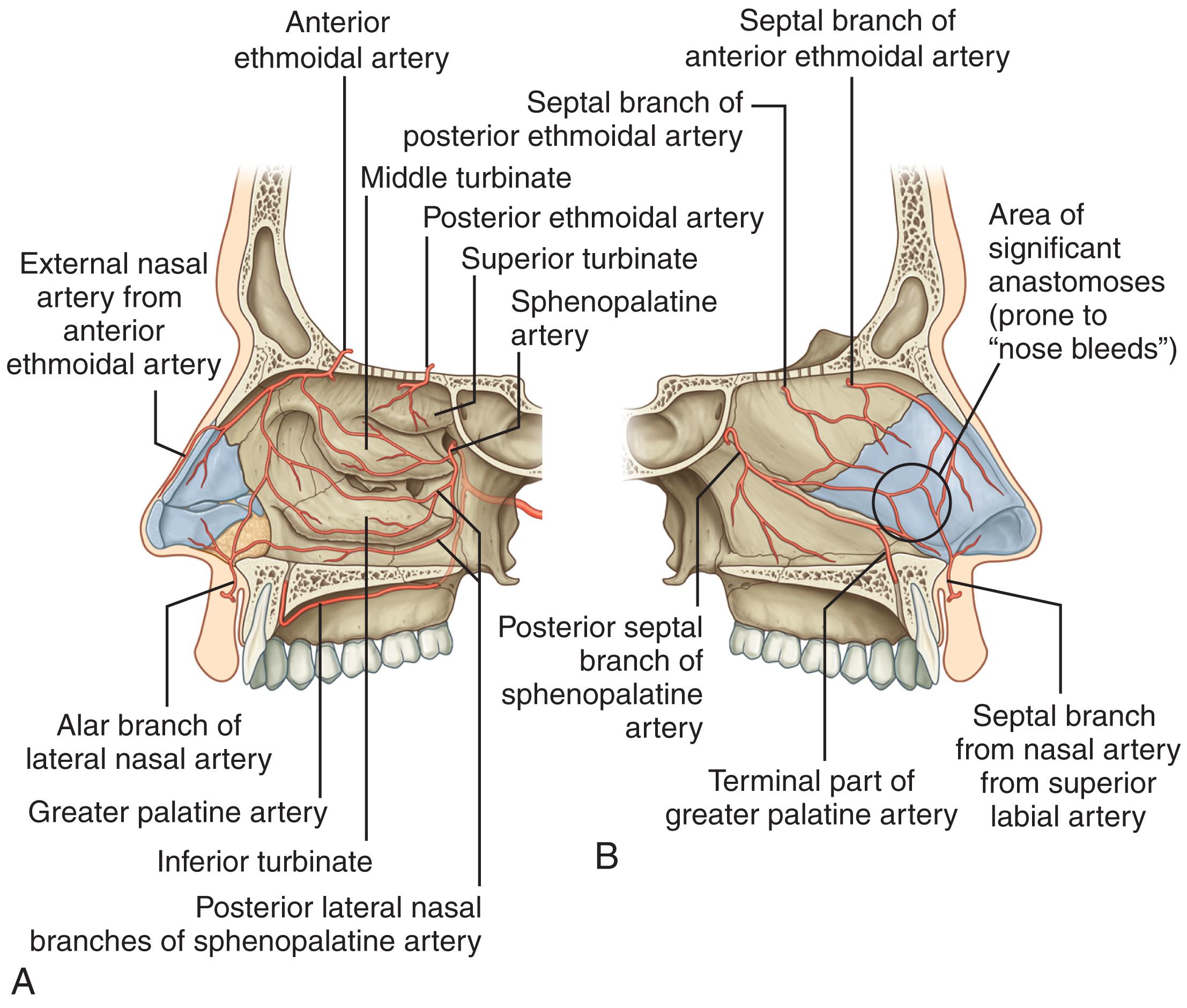Physical Address
304 North Cardinal St.
Dorchester Center, MA 02124
Anterior epistaxis is the most common and often originates from Little’s area in Kiesselbach’s plexus, whereas posterior bleeds commonly originate from the sphenopalatine artery distribution.
The most important initial evaluation is a rough gauge of epistaxis severity and, if needed, status of ABCs (airway, breathing, and circulation) and vital signs. This plays the key initial role in evaluation and planning.
There are a number of modifiable factors that should be kept in mind in the treatment of chronic epistaxis, such as current medications, home/work environment, and indoor humidity at place of residence.
In cases of repeated epistaxis without an identified cause, conditions such as coagulopathy, vascular abnormality, drug use, hereditary disorders, and inflammatory and autoimmune conditions should be considered.
When considering intervention for posterior epistaxis, SPA ligation is a more efficacious and cost-effective means of controlling epistaxis compared to posterior packing and hospitalization or embolization. The latter may be preferred in the poor surgical candidate.
Wegener granulomatosis, now referred to as granulomatosis with polyangiitis (GPA), affects the upper airway, kidneys, and lungs and can present to the otolaryngologist as epistaxis, nasal obstruction, olfactory dysfunction, hearing loss, or subglottic stenosis.
Conditions to be considered in a patient with epistaxis and thrombocytopenia: massive hemorrhage, disseminated intravascular coagulation (and associated underlying medical issues such as sepsis), thrombotic microangiopathy, heparin- or other drug-induced thrombocytopenia, idiopathic thrombocytopenic purpura, and bone marrow suppression.
A patient who requires posterior nasal packing should be admitted to the hospital and placed on telemetry and continuous pulse oximetry.
In general, endoscopic sphenopalatine artery ligation for posterior epistaxis is both more effective and more cost beneficial than arterial embolization.
A teenage male presenting with unilateral nasal obstruction and epistaxis should raise suspicion for juvenile nasopharyngeal angiofibroma (JNA). JNA is a highly vascularized benign tumor that originates near the medial pterygopalatine fossa (PPF). Diagnosis is made by classic history and radiology (widening of the PPF and anterior bowing of the posterior maxillary sinus wall or Holman-Miller sign); biopsy should be avoided due to risk of hemorrhage.
Epistaxis occurs in 60% of the population in the United States; approximately 6% of people who experience epistaxis will seek medical attention. The vast majority of episodes are benign and self-limited. Epistaxis accounts for 0.5% of all emergency department visits and one-third of all otolaryngology-related emergency department encounters. Epistaxis occurs in all age groups with a bimodal distribution in the young and elderly; it is categorized into childhood versus adult epistaxis, or primary versus secondary epistaxis, which is important for diagnostic and therapeutic decision-making.
The anterior and posterior ethmoid arteries supply the superior nasal cavity and septum; they arise from the ophthalmic branch of the internal carotid artery. The sphenopalatine artery is the terminal branch of the internal maxillary artery (from the external carotid circulation) and supplies the posterior lateral nasal wall and nasal cavity. The facial artery, also from the external carotid distribution, provides additional supply to the anterior nasal cavity ( Fig. 24.1 ).

Kiesselbach’s plexus is a confluence of vessels arising from both the internal and external carotid artery systems. It supplies an area on the anterior-inferior nasal septum known as Little’s area, the most common site for epistaxis.
Woodruff’s plexus is a confluence of thin-walled veins located posteriorly in the inferior meatus. This area was previously thought to be arterial and also thought to be a main contributor to posterior bleeds, but this does not appear to be the case.
The majority of bleeds (90% to 95%) originate anteriorly; many of the anterior bleeds occur in Little’s area within Kiesselbach’s plexus. Occurring much more often than posterior bleeds because of their location (nose picking/local trauma, dryness), anterior bleeds are easily accessible and managed with conservative measures such as moisturization, pressure, decongestion, or topical cautery. Posterior bleeds are generally from the distribution of the sphenopalatine artery and are the cause of 5% to10% of epistaxis. The exact focus of origin is more challenging to identify, and these bleeds are therefore more likely to require nasal packing as part of intervention.
In an emergent setting, emphasis should be placed on managing airway, breathing, and circulation with volume replacement as needed and a focused history to expedite locating the source by nasal endoscopy and controlling hemorrhage. In the nonemergent setting, a careful and thorough history and physical exam can be obtained. The history should include timing, frequency, sidedness, and severity of epistaxis (which can be quantified by volume of observed blood or number of tissues), exploring predisposing conditions such as trauma, recent surgery, coagulopathy, cancer, medications and illicit drug use, contributory chronic medical issues, and current symptoms indicative of blood loss such as lightheadedness or dyspnea. Family history of bleeding disorder or epistaxis is also worthy of inquiry.
(1) Instruct the patient to gently blow the nose. This removes blood/clots. (2) Intranasal administration of nasal decongestant spray such as oxymetazoline (a selective alpha-1 agonist/partial alpha-2 agonist). (3) Instruct the patient to pinch the nasal alae against the septum to apply hemostatic pressure and hold for 10 to 15 minutes, or longer if needed. (4) Place a cold compress over the bridge of the nose, if available.
Having the head tilted posteriorly may result in posterior drainage of blood, increasing the potential for aspiration and/or gastric irritation with resultant bloody emesis. Additionally, having the blood fall back into the throat and be swallowed makes it difficult to quantify the amount of bleeding.
Become a Clinical Tree membership for Full access and enjoy Unlimited articles
If you are a member. Log in here